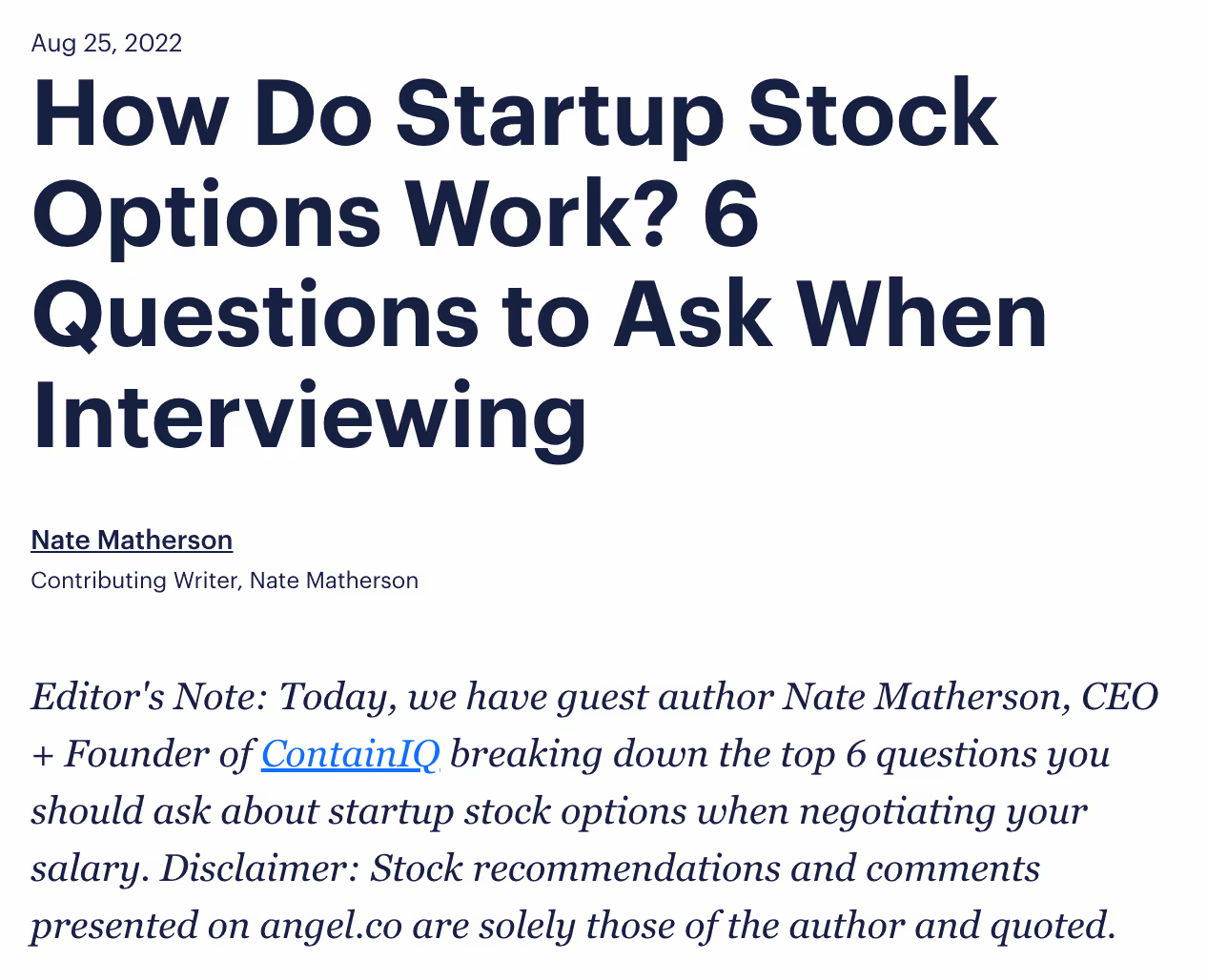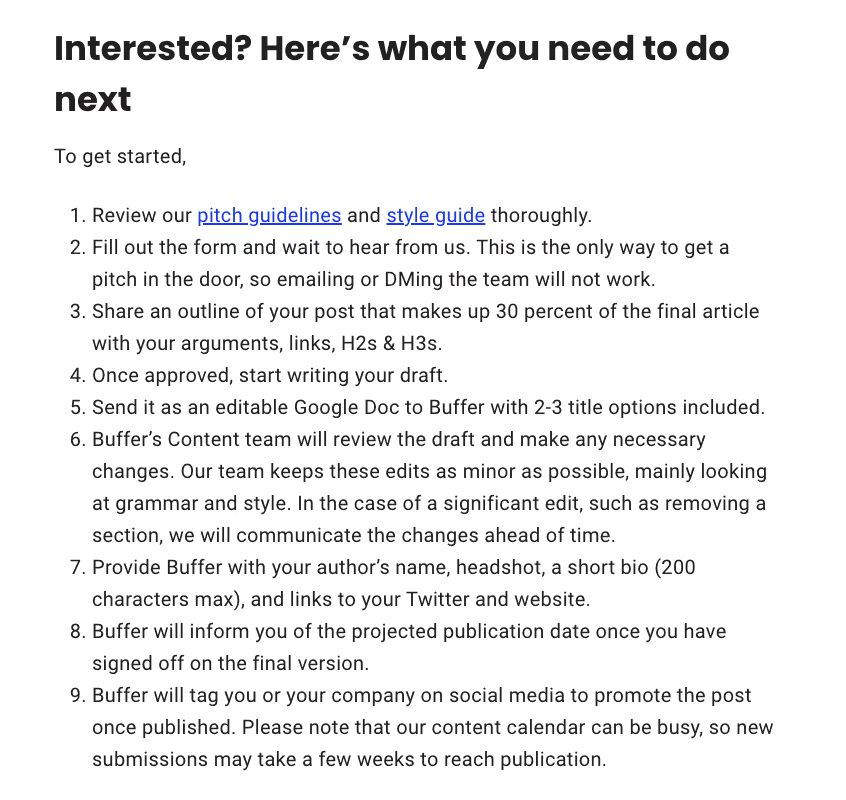Guest blogging remains a popular tactic for building backlinks to a website. Writing a post for a high-authority blog can pass powerful PageRank, or “link juice,” from that site to yours, which can help boost your search rankings.
But there’s an art to building backlinks. For example, the higher the quality of the sites that you guest post on, the more effective your link building will be.
After writing more than 300 guest posts, I’ve compiled a tried-and-tested guide you can use to place your posts (and backlinks) on desirable sites.
What Is Guest Blogging?
Guest blogging is simply writing a post for another blog or website. Most guest authors get credit for their contribution in the form of a short bio and at least one link, which can be used to pass PageRank from one site to another. A guest author can often include links to specific pages on their website within the body of the guest post as well.
Best of all, guest blogging is a free tactic that not only builds backlinks, but also extends your reach and helps establish your expertise in your field.
You’ll often see the “guest post” or “guest author” tag on a guest post, followed by a bio that highlights the company the author works for.

What Are the Benefits of Guest Blogging?
There are two ways of looking at the benefits of a guest blogging strategy:
- The benefits for the writer.
- The benefits for the owner of the host website.
If a guest blog post is well written and useful, it’s a win-win. Let’s break it down.

The Benefits of Guest Blogging for the Writer
- Building backlinks: The author can link back to their website and build their backlink portfolio.
- Using targeted anchor text: The writer can choose which words anchor the links to their webpages, so they can target specific keywords.
- Reaching a new audience: The author gets in front of an audience they might otherwise not have been able to reach.
- Building your brand: Getting published on high-authority industry sites helps the author boost their reputation as an expert and helps grow their brand’s visibility.
The Benefits of Guest Blogging for the Host
- Bringing in new, expert authors: Website owners can breathe new life into their blogs with posts from new authors who have different perspectives and areas of expertise.
- Get very low-cost content: Guest authors aren’t typically paid for their work, but there are some small costs involved, such as editing and graphic design.
Getting Started with Guest Posting
Guest posting can feel incredibly daunting when you’re just starting. Creating great content can be difficult, and you’ll want to take the time to get everything right when you’re writing for popular blogs in your industry.
If you’re ready to take on the challenge, here’s how to get started.
1. Find Guest Post Opportunities
Manual Google Search
Start by searching for other blogs in your industry or space. You can search on Google using search terms like:
- [Your industry] “write for us”
- [Your industry] “guest post”
For example, typing the search term “marketing ‘write for us’” reveals hundreds of potential guest post opportunities. Add opportunities to a spreadsheet so you can keep track of them.

Social Media Search
Social media channels can be a goldmine for guest blogging opportunities. Use a tactic similar to a Google search by typing “[your industry] guest post” or relevant hashtags into the search bar on X (formerly Twitter) or LinkedIn.

Traditional Media Opportunities
In addition to relevant blogs, look for traditional media outlets you can contribute to — many provide a way to submit a pitch or a piece. You can either home in on niche-specific publications or broaden your search to include large outlets with dedicated columns or sections.
Find Your Friends
You’re probably friendly with at least two or three other startup founders or business owners in your field. Tap your network to see whether any of your friends are open to accepting a guest post or doing a guest post swap with your website (but when it comes to swaps, beware of creating a link network — more on this later).
Pro Tip: For startups, you can also guest post on your investor's websites as they will often have blogs.
Customers and Vendors
If you have good relationships with certain customers or vendors, you can ask them if they’d be open to taking a guest post from you. This can work well if you’re trying to reach more companies in the same niche.
Check Your Competitors
Have a look at where your competitors have contributed guest posts by searching their name and “guest author” in Google, or by keeping tabs on their social media accounts.

2. Come Up with Your Pitch
Once you’ve identified a list of blogs to target, you can start working on your pitch. The topic you submit to each publication should be relevant to its audience and your business objectives — for example, a piece about Instagram influencer marketing tactics might interest a blog’s audience, but if your company provides direct mail services, that topic probably won’t be a good fit.
Identify Potential Topics
Finding content gaps can be a great way to strengthen your pitch. A blog is unlikely to publish a guest post on a topic that’s already been covered, unless the post provides a brand-new perspective or unique information. In addition to scouring existing posts, you can run a quick Google search for the site’s (or publication’s) name and the topic you want to write about to see whether the site has any previous posts about that topic.

For example, this search shows existing content about automated chatbots on Gorgias’ website. Avoid pitching anything closely related to these topics and instead find where there’s a gap. However, if there’s not a single existing post on a specific topic, check that it’s still relevant—there might be a reason for it.
You can take this a step further and use a keyword tool to do some content gap research and find out what topics the site’s competitors have covered.
Come Prepared With Multiple Ideas
I always recommend coming up with two to three ideas for each publication. This gives you multiple chances to have your pitch chosen without having to enter a lengthy back-and-forth with the person managing the blog or site.
Look at the Site’s Submission Guidelines
Checking the blog’s submission guidelines is important. Sometimes, you’ll be asked to share a paragraph or two about your chosen topic, while others might ask for a headline and a sentence explaining your idea.
For example, here’s a snippet of Buffer’s guest post guidelines:

3. Pitch the Blogs
Now, it’s time to reach out to the site owners and submit your pitches. Here are some ways you can enhance your pitch and increase your chances of getting published.
Write Short Emails
Keep your pitch emails short and sweet — a paragraph or two at most — and make sure to include all the information the site owner or content team will need to make a decision, including:
- Your name and your website details.
- Why you’re qualified to write the posts you’re pitching.
- Your topic ideas and explanations.
- Any other information the submission guidelines require.
Be Incredibly Clear
In addition to keeping your pitches short, make sure they’re crystal clear. Help whoever is reading your pitch make a quick decision by outlining exactly why you’re emailing. Some people suggest that you mention how much you love the site and that you’ve been a longtime reader, but most site owners just want to know whether your idea is good enough to publish (and whether you can execute it well!).
Include Social Proof
Does your site have good traffic? Do you have a decent amount of followers on social media? If you do, mention this in your pitch. Having a pre-built audience you can share the piece with will work in your favor.
Provide Writing Samples
Reputable sites have quality standards for what they publish. Sharing a selection of your previously published writing shows that you are able to produce high-quality work.
For best results, share writing samples that are relevant to the topic you’re pitching. This will help demonstrate your subject matter expertise as well as your writing chops.
Find the Right Email Address
One of the hardest parts of pitching a guest post isn’t the actual pitching or the writing — it’s finding the right person to email. For newspapers, there are often op-ed editors assigned to each column. Some websites have dedicated emails for pitching guest posts, while to reach others, you might have to find the email address of the blog owner or editor.
If you’re struggling to find the right person to email, a quick LinkedIn search can do the trick: simply type “[publication name] owner [or editor]” into the search bar. You can then reach out to the person via LinkedIn or use a tool like Email Finder to get their email address.

4. Write Your Guest Post
Now the fun can start. Writing a guest post can be time-consuming — but that’s because you want to make sure it’s the best it can be.
Here are some tips to help you write your guest post.
Keep the Bar High
Treat every guest post as if it were a post on your own website. Decide whether you’d be happy to publish it on your site or if you’d approve it as a guest post submission from someone else. It can be tempting to do a rush job, but maintaining high standards will help ensure that your post (as well as future posts) is accepted.
Use tools like Grammarly and Hemingway to make sure your post is grammatically correct and reads well (but keep in mind that these tools are not entirely infallible), and study the existing content on the blog you’re pitching to see how posts are formatted. (For instance, are headers initial-capped? How do they handle citations? Do they use pull text or pull quotes?) Deliver a post that’s formatted the way their published posts are.
Think About Including Visuals and Personal Stories
Great blog posts often include visuals — charts, screenshots, and so on. If you add visuals to posts on your blog, do the same for your guest posts. Also consider how your personal experiences can be used to make your posts unique. Some of the best guest posts share the author’s experiences and real-life anecdotes, because they give the audience a new, unique perspective.
Consider Hiring an Editor
Many guest posts will go through the publishing site’s editorial process, but you can speed up the process and forestall revision requests by hiring your own editor to review your piece before you submit it. A good editor will not only fix any potentially embarrassing typos; they’ll also double-check your facts, improve your piece’s flow and readability, flag any potential gaps, and ensure that you’re submitting the best possible piece.
Include Backlinks to Your Website
Don’t forget the main aim of your guest blogging efforts: to secure backlinks to your website. Some submission guidelines will have a strict limit on how many links you can include (for many, it’s two to three), while others will let you include a link only in your author bio.
If you can, include up to three links back to your website — for example, you might add one to your homepage, one to a relevant blog post, and one to a specific resource. The key is to not overdo it. You want the links and anchor text to feel natural so that readers are encouraged to click through.
5. Promote Your Guest Post
Now all the hard work is done, it’s time to reap the rewards. The more you share your published guest post, the more people will see it. Work with the website to cross-promote your guest blog and share it on all of your channels.
Here are some ways you can promote your guest blog:
- Send an email: Share your guest post with your email list as soon as it’s live (and make sure the website shares your post by email as well).
- Share on social: Create a few social posts for your different channels that you can schedule to go out over the next several weeks.
- Add a link to your site: Advertise your guest post on your own website, whether that’s with a snippet in your blog or on a dedicated guest blogging page.
Here’s an example of how Emma shares a guest blog post with its subscribers:

Tips and Tricks to Make Guest Blogging Work for You
Guest blogging can be a great way to increase your visibility in your niche and generate backlinks in the process. But as I said at the outset, there’s an art to it — especially if you want to get the best results in the shortest amount of time.
Here are some tips I’ve picked up along the way:
It Can Be a Numbers Game
You won’t see huge results after guest blogging on one site — even if that site has high authority. It takes time to build a backlink portfolio via guest posting, so it’s worth baking one or two guest posts into your strategy every month. You’ll start to notice the results when you’ve written a dozen or more guest posts.
Write for Blogs You Haven’t Received Backlinks From
It’s easier to pitch blogs that have already linked to you or accepted guest posts, but the link juice from these plateaus after a while. Instead, target blogs you haven’t yet received backlinks from, as these will be stronger and help you build a more varied backlink portfolio.
UGC Sites Are Less Valuable
While sites like Medium make it easy to submit guest posts and link back to your site, they’re not as valuable as guest posting on sites that have submission guidelines and aren’t based on sharing user-generated content (UGC).

Go for Sites That Provide Dofollow Links
Google marks links in two ways:
- Nofollow links don’t influence search engine rankings because Google doesn’t transfer any PageRank from them.
- Dofollow links do influence search engine rankings.
Guest posting on sites that give only nofollow backlinks is still worthwhile, but try to pick sites that will provide a dofollow backlink if you want to grow your authority and backlink portfolio.
Mix Up Your Anchor Text
Don’t use the same anchor text every time you link to your website from a guest post. Instead, use related keywords and different phrases. For example, rather than always linking from the name of your website, try using anchor text that describes your product (like “best productivity tool”).
The Risks of Guest Blogging
Despite the many benefits of guest blogging, there are some risks to bear in mind before you get started:
- Don’t overdo it: Don’t rely solely on guest posting to generate backlinks. Ideally, you want to be building links in many different ways, including resource pages, digital PR, and so on, as well as guest blogging.
- Keep the bar for quality high: Avoid guest posting on a large number of low-quality or spammy sites — this can do more harm than good, even if the lower-quality sites are easier to submit to.
- Don’t pay for opportunities: Unless you explicitly want sponsored content, don’t pay to guest post on any site, no matter how big or popular it is.
- Be wary of guest post swaps: Exchanging too many guest posts with other sites can create a link network, which Google frowns on — this is fine on a small scale, but be mindful about not creating a backlink network over time.
4 Examples of Guest Blogging Done Right
Here’s a selection of guest posts I’ve written over the years on various types of websites — from startup blogs to national newspapers.
1. Guest Posting on an Industry Site

This guest post I wrote for the Cloud Native Computing Foundation covered a super technical industry topic. It shows that I know my stuff while also generating a backlink from a top industry site.
2. Guest Posting on a Traditional Media Site

Most people in the tech world have heard of VentureBeat. This guest post earned me a bit of clout as well as a backlink.
3. Guest Posting on a Newspaper

Guest posting for a newspaper, like I did here for The Gazette, can help you reach a broader, more diverse audience of people who might otherwise not see your content.
4. Guest Posting on Another Startup’s Website

This guest post for Explo provided a great opportunity to reach a targeted audience. It’s not the most widely viewed site I’ve written for, but it was all about reaching the right people.
Final Thoughts
Guest blogging is one of the oldest link-building strategies out there — and there’s a reason it’s still a common SEO tactic. Securing posts on high-quality sites with decent authority transfers link juice from their site to yours, which, ultimately, bumps you up in search results. The key is to find relevant sites and pitch posts that are useful and interesting for the site’s audience (and your own audience!).
But don’t rely on guest posting alone. You should bake it into your overall SEO efforts, which should include other link-building strategies like data-driven content and resource pages. This will help you build a comprehensive and varied backlink portfolio — something Google’s algorithm takes into account.





